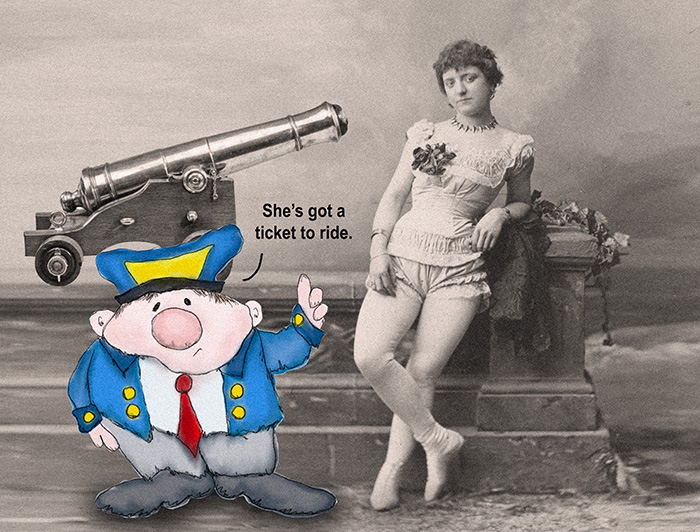Boom. As defined, a boom is a loud, deep, resonant sound. We know them when we hear them.
Cannon. A large, heavy piece of artillery, typically mounted on wheels. We know them when we see them too.
And. Human. A human being, especially a person as distinguished from an animal. We know them. We are one.
But these three things don’t seem like they belong together. Nonetheless. On April 2, 1877, the first human cannonball was thrust into the air. A cannon was to blame.
First, there was an explosion, then a puff of smoke. And then, there she went flying about 60 feet above the heads of an awe-struck crowd. Her name was Rosa Matilda Richter. At the point of explosion, she was a measly 14-year-olds. An English girl.
Rosa performed under the name of “Zazel” which was very eccentric, not sounding English at all. But she didn’t start out as a cannonball. Nope. She was a tightrope walker and aerial acrobat. She took up ballet, gymnastics, and trapeze by the time she was six. She must have had some talent, as, at age twelve, she went on tour with a traveling acrobat troupe. Before that, she was probably just a normal kid. For those five and a half years at the start.
Young, young Rosal learned her skills from William Hunt. He was a Canadian who went by the name of The Great Farini. Everybody knew Farini. He had earned great fame for performing a high-wire walk above Niagara Falls.
Who knows how people come up with the ideas that they do. Like why walk over the Niagra Falls on a tightrope when they have perfectly good walkways all the way around the thing. And his idea for the human cannonball? Maybe Farina was eating some beans, and he tooted. Maybe it took him to loftier places. No matter how it came about, in 1871, he patented the mechanism for the human cannonball cannon. And that meant launching a human projectile through the air into a safety net.
Fortunately for little Rosa, the process did not actually involve any explosives. It was all smoke and mirrors. Or something close. The “cannon” was really a system of springs and tension, which was followed by a fake explosion and smoke.
The big boom with little Rosa took place at the Royal Aquarium. The structure was built next to Westminster Abbey, and its sole purpose was for entertainment venues. But there was Zazel. Being thrust out of a cannon, night after night. She continued on this way, being fortunate to survive. Zazel played to crowds of more than 20,000 in England and the United States. Throughout her career, Rosa suffered several accidents and injuries. The worst? She broke her back, and it ended her career in 1891. She was 31 years old then.
Of course, the very first cannon came long before Rosa. It showed up during the 12th century. It was invented in China, probably by some warlord. Before the cannon, they had a weapon called the “fire lance” which was also a gunpowder weapon. Projectiles and gunpowder. Explosive. But at least they weren’t launching humans. That we know of.
Which brings me to this. Most of the time, our lives go this way and that, without too many highs and lows. Most of the time.
Yet, ever so often, it feels like someone stuffed us into a cannon and shot us out, flying, flailing, through the air, to destinations unknown. It can be explosive and abrupt. And? The impending fall may hurt us. In ways we never imagined.
And in all of that, we can only hope there will be a safety net, waiting for us at the end. As we are flying through the air, we can only hope.
Others may be standing by, watching and hoping too. But we are the ones moving through it all. And when we hit the net, we climb out of the tangled mess and begin to walk again, to someplace different.
===========
“Is this thing safe?”
“Safe as life,” Gansey replied.”
― Maggie Stiefvater, The Raven Boys
============
We are only puppets, our strings are being pulled by unknown forces.
— Georg Buchner
============
All we know is still infinitely less than all that remains unknown.
— William Harvey
==========
Flying into the unknown
